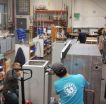(Press-News.org) CORVALLIS, Ore. – Engineers at Oregon State University have developed a new approach toward "sustainable manufacturing" that begins on the factory floor and tries to encompass the totality of manufacturing issues – including economic, environmental, and social impacts.
This approach, they say, builds on previous approaches that considered various facets of sustainability in a more individual manner. Past methods often worked backward from a finished product and rarely incorporated the complexity of human social concerns.
The findings have been published in the Journal of Cleaner Production, and reflect part of society's growing demands for manufacturing systems that protect both people and the environment, while still allowing companies to be economically viable and make a profit on their products.
"People around the world – and many government policies – are now demanding higher standards for corporate social responsibility," said Karl Haapala, an OSU assistant professor of industrial and manufacturing engineering. "In the early days, industry dealt with 'end-of-pipe' challenges to reduce pollution or increase efficiency. There's still a place for that, but we're trying to solve the problem at the source, to begin the process right at the drawing board or on the shop floor."
"We want to consider a whole range of issues every step of the way," Haapala added, "so that sustainability is built into the entire manufacturing process."
The researchers demonstrated the approach with the production of stainless steel knives, based on an industry project. But the general concepts could be used for virtually any system or product, they said.
With every decision the method considers manufacturing techniques, speed of the operations, environmental impacts, materials, energy used and wastes. Decisions can be based on compliance with laws and regulations, and the effects of different approaches on worker safety and satisfaction.
"This is one of the few approaches to systematically consider the social aspects of the workplace environment, so that people are happy, productive, safe, and can contribute to their families and communities," said Hao Zhang, a doctoral student in the College of Engineering and graduate research assistant on the study.
"Suppose we make changes that speed up the output of a manufacturing line," Zhang said. "In theory that might produce more product, but what are the impacts on tool wear, increased down time or worker satisfaction with the job? What about risk of worker injury and the costs associated with that? Every change you make might affect many other issues, but too often those issues are not considered."
Social components have often been left out in the past, Zhang said, because they were some of the most difficult aspects to scientifically quantify and measure. But health, safety and happiness that start on the workshop floor can ripple through the entire community and society, Haapala said, and they are too important to be pushed aside.
This approach incorporates previous concepts of sustainability that have been found to have proven value, such as "life cycle assessment" of systems that considers the totality of energy used, environmental impacts and other issues. And it lets manufacturers make value judgments about the issues most important to them, so that a system can prioritize one need over another as necessary.
OSU researchers are further developing these approaches in collaboration with Sheldon Manufacturing, Inc., of Cornelius, Ore., a designer and manufacturer of laboratory equipment. This work has been supported by Benchmade Knife Co., Sheldon Manufacturing and the Oregon Metals Initiative.
These demands are a special challenge to small and medium sized companies that may not always have the necessary broad range of engineering expertise, the OSU engineers said. They hope the systems being developed can be implemented at many levels of manufacturing.
INFORMATION:
Editor's Note: A digital image to illustrate this story is available online: http://bit.ly/1gixrUG
The study this story is based on is available online: http://bit.ly/1d1A4YE
Sustainable manufacturing system to better consider the human component
2014-02-20
ELSE PRESS RELEASES FROM THIS DATE:
New calibration confirms LUX dark matter results
2014-02-20
PROVIDENCE, R.I. [Brown University] — A new high-accuracy calibration of the LUX (Large Underground Xenon) dark matter detector demonstrates the experiment's sensitivity to ultra-low energy events. The new analysis strongly confirms the result that low-mass dark matter particles were a no-show during the detector's initial run, which concluded last summer.
The first dark matter search results from LUX detector were announced last October. The detector proved to be exquisitely sensitive, but found no evidence of the dark matter particles during its first 90-day run, ruling ...
Better broccoli, enhanced anti-cancer benefits with longer shelf life
2014-02-20
URBANA, Ill. – While researching methods to increase the already well-recognized anti-cancer properties of broccoli, researchers at the University of Illinois also found a way to prolong the vegetable's shelf life.
And, according to the recently published study, the method is a natural and inexpensive way to produce broccoli that has even more health benefits and won't spoil so quickly on your refrigerator shelf.
Jack Juvik, a U of I crop sciences researcher, explained that the combined application of two compounds, both are natural products extracted from plants, increased ...
Smaller meals more times per day may curb obesity in cats
2014-02-20
URBANA, Ill. – Just as with people, feline obesity is most often linked to excessive food intake or not enough physical activity. Attempts to cut back on calories alone often result in failed weight loss or weight regain in both people and their pets.
So how do you encourage your cat to get more exercise?
Researchers from the University of Illinois interested in finding a method to maintain healthy body weight in cats, looked at a previously suggested claim that increased meal frequency could help to increase overall physical activity.
The idea is to feed cats the ...
Color vision problems become more common with age, reports Optometry and Vision Science
2014-02-20
Philadelphia, Pa. (February 20, 2014) - Abnormal color vision increases significantly with aging—affecting one-half or more of people in the oldest age groups, reports a study in Optometry and Vision Science, official journal of the American Academy of Optometry. The journal is published by Lippincott Williams & Wilkins, a part of Wolters Kluwer Health.
While few people younger than 70 have problems with color vision, the rate increases rapidly through later decades of life, according to the new research by Marilyn E. Schneck, PhD, and colleagues of The Smith-Kettlewell ...
Roots to shoots: Hormone transport in plants deciphered
2014-02-20
Plant growth is orchestrated by a spectrum of signals from hormones within a plant. A major group of plant hormones called cytokinins originate in the roots of plants, and their journey to growth areas on the stem and in leaves stimulates plant development. Though these phytohormones have been identified in the past, the molecular mechanism responsible for their transportation within plants was previously poorly understood.
Now, a new study from a research team led by biochemist Chang-Jun Liu at the U.S. Department of Energy's (DOE) Brookhaven National Laboratory identifies ...
New research shows the way a room is lit can affect the way you make decisions
2014-02-20
The next time you want to turn down the emotional intensity before making an important decision, you may want to dim the lights first.
A new study from the University of Toronto Scarborough shows that human emotion, whether positive or negative, is felt more intensely under bright light. Alison Jing Xu, assistant professor of management at UTSC and the Rotman School of Management, along with Aparna Labroo of Northwestern University, conducted a series of studies to examine the unusual paradox of lighting and human emotion.
"Other evidence shows that on sunny days people ...
Recurrent mouth and throat cancers less deadly when caused by virus, study shows
2014-02-20
People with late-stage cancer at the back of the mouth or throat that recurs after chemotherapy and radiation treatment are twice as likely to be alive two years later if their cancer is caused by the human papillomavirus (HPV), new research led by a Johns Hopkins scientist suggests.
Previous studies have found that people with so-called HPV-positive oropharyngeal cancers are more likely to survive than those whose cancers are related to smoking or whose origins are unknown.
The new study, scheduled to be presented Feb. 20 at the 2014 Multidisciplinary Head and Neck ...
Humidification of the mouth, throat during RT for head and neck cancer reduces mucositis, hospital stay
2014-02-20
Scottsdale, Ariz., February 20, 2014—Patients who received daily humidification of the mouth and throat region beginning from day one of radiation therapy treatment spent nearly 50 percent fewer days in the hospital to manage their side effects, according to research presented today at the 2014 Multidisciplinary Head and Neck Cancer Symposium.
The study was conducted by the Trans Tasman Radiation Oncology Group and evaluated 210 head and neck cancer patients in New Zealand and Australia from June 2007 through June 2011. Patients in this Phase III trial were randomized ...
HPV-positive OPSCC patients nearly twice as likely to survive as HPV-negative patients
2014-02-20
Scottsdale, Ariz., February 20, 2014—A retrospective analysis of oropharyngeal patients with recurrence of disease after primary therapy in the Radiation Therapy Oncology Group (RTOG) studies 0129 or 0522 found that HPV-positive patients had a higher overall survival (OS) rate than HPV-negative patients (at two years post-treatment, 54.6 percent vs. 27.6 percent, respectively), according to research presented today at the 2014 Multidisciplinary Head and Neck Cancer Symposium.
The analysis included 181 patients with stage III-IV oropharyngeal squamous cell carcinoma (OPSCC) ...
HPV-positive SCCOP patients' recurrence differs from HPV-negative patients
2014-02-20
Scottsdale, Ariz., February 20, 2014—Patients with HPV-positive squamous cell carcinoma of the oropharynx (SCCOP) had a longer time to development of distant metastasis (DM) after initial treatment, and had more metastatic sites in more atypical locations compared to HPV-negative patients, according to research presented today at the 2014 Multidisciplinary Head and Neck Cancer Symposium.
Culled from records of an IRB-approved registry, the study reviewed 285 patients with stage III-IV SCCOP (originally thought to be a smoking-related head and neck cancer) treated with ...


